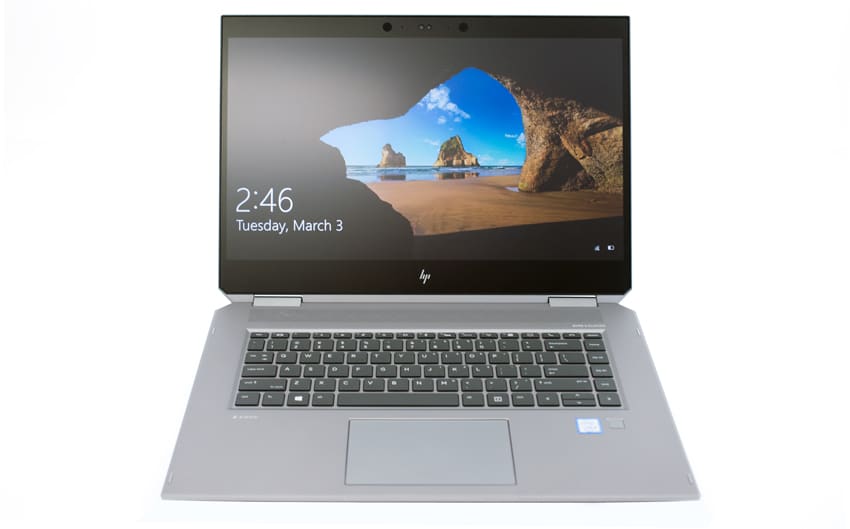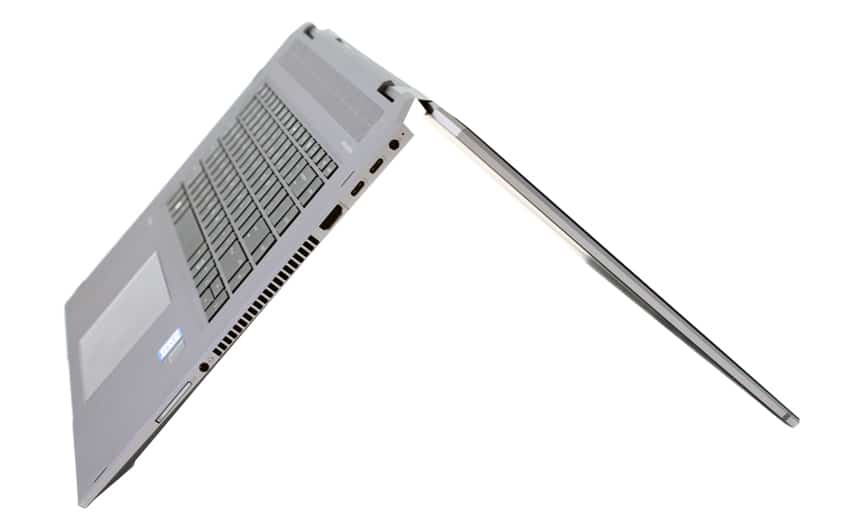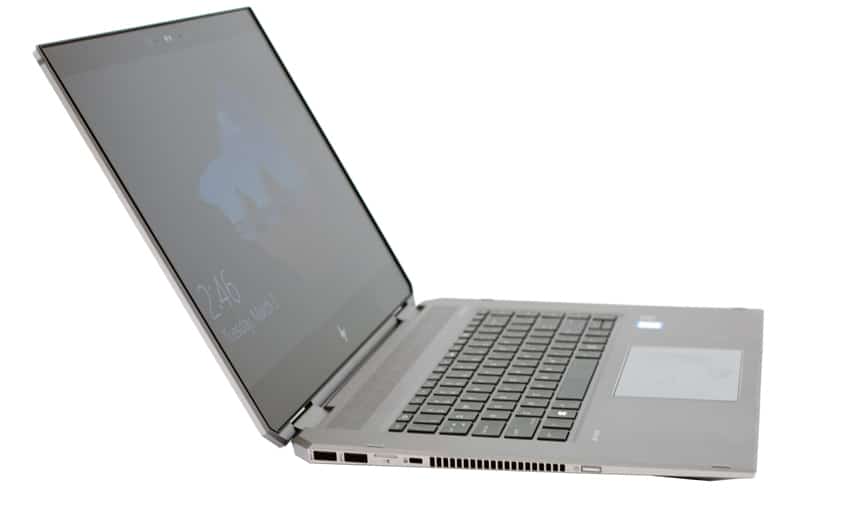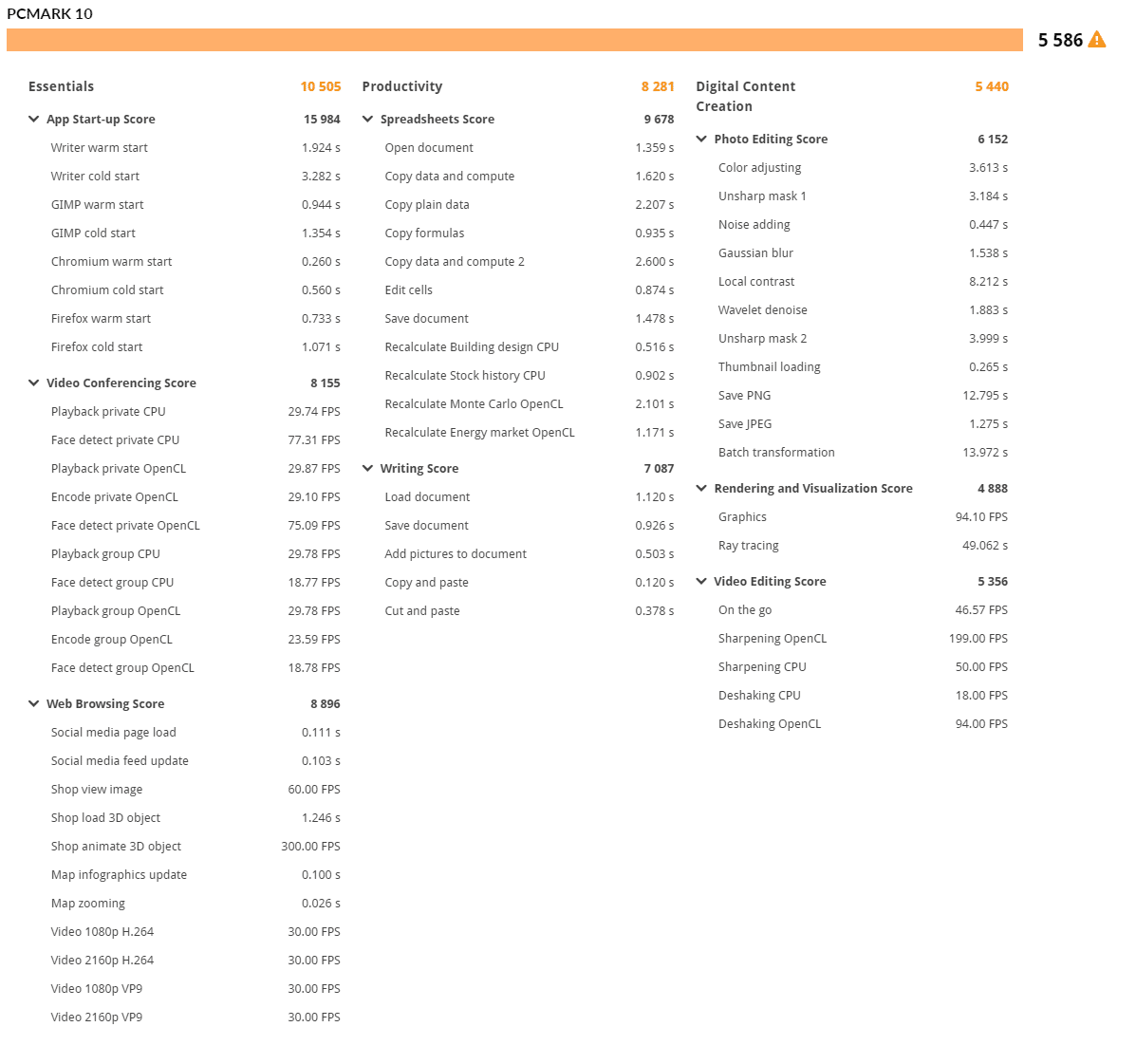The HP ZBook Studio x360 G5 workstation is a versatile hybrid notebook that is ideal for those working in fields like 3D developing, architecture, and design. We’ve previously looked at the HP ZBook Studio x360 G5 Workstation and we found it to be a flexible high-performance machine. This year we’re taking a look at an update of that same workstation with some alternate specs and shifting from an enterprise build to more of a consumer build. With a brief look at the spec sheet it’s pretty obvious this workstation is well-suited for resource-intensive workloads. It can be decked out with options such as a range of 8th-generation six-core Intel Core i9 or Xeon processors, up to 64GB of RAM, and NVIDIA Quadro professional graphics up to the P2000.
The HP ZBook Studio x360 G5 workstation is a versatile hybrid notebook that is ideal for those working in fields like 3D developing, architecture, and design. We’ve previously looked at the HP ZBook Studio x360 G5 Workstation and we found it to be a flexible high-performance machine. This year we’re taking a look at an update of that same workstation with some alternate specs and shifting from an enterprise build to more of a consumer build. With a brief look at the spec sheet it’s pretty obvious this workstation is well-suited for resource-intensive workloads. It can be decked out with options such as a range of 8th-generation six-core Intel Core i9 or Xeon processors, up to 64GB of RAM, and NVIDIA Quadro professional graphics up to the P2000. 
Our updated build includes an Intel Core i9-8950HK, 64GB of DDR4 non-ECC RAM, NVIDIA P2000 GPU, Toshiba XG5 512gb NVMe SSD, and a DreamColor touchscreen.
The previous build included an Intel Xeon E-2186M, 32GB of DDR4 ECC RAM, 1TB NVMe M.2 SSD, NVIDIA Quadro P1000 (4GB VRAM), and the 15.6″ 4K IPS eDP LED-backlit touch screen.
Key Specification Differences between the HP ZBook Studio x360 builds include:
| New x360 | Old x360 | |
| CPU | Intel Core i9-8950HK | Intel Xeon E-2186M |
| GPU | NVIDIA P2000 | NVIDIA P1000 |
| RAM | 64GB of DDR4 non-ECC RAM | 32GB of DDR4 ECC RAM |
| Display | DreamColor | non-DreamColor |
HP ZBook Studio x360 G5 Specifications
| CPU Family | Intel Xeon processor (E-2176M, E- 2186M) 8th Generation Intel Core i9 processor (i9-8950HK) 8th Generation Intel Core i7 processor (i7-8750H, i7-8850H) 8th Generation Intel Core i5 processor (i5-8300H, i5-8400H) |
| Maximum Memory | 64 GB DDR4-2667 non-ECC SDRAM 32 GB DDR4-2667 ECC SDRAM 32 GB DDR4-2667 non-ECC SDRAM 5,34 Transfer rates up to 2667 MT/s |
| Memory Slots | 2 SODIMM |
| Storage | 256GB up to 1TB SATA SSD Up to 256GB M.2 SATA SED SSD 256 GB up to 2 TB PCIe NVMe M.2 SSD 256 GB up to 512 GB PCIe NVMe M.2 SED SSD 2 x 1TB up to 2x2TB PCIe NVMe M.2 SSD |
| Display | HP Sure View 15.6″ diagonal FHD IPS eDP + PSR LED-backlit touch screen with Corning Gorilla Glass 4, 650 cd/m2 (1920 x 1080) HP DreamColor 15.6″ diagonal 4K IPS LED-backlit touch screen with Corning Gorilla Glass 4, 600 cd/ m2, 100% AdobeRGB (3840 x 2160) HP DreamColor 15.6″ diagonal 4K IPS LED-backlit anti-glare touch screen with Corning Gorilla Glass 4, 600 cd/ m2, 100% AdobeRGB (3840 x 2160) 15.6″ diagonal FHD IPS eDP + PSR LED-backlit touch screen with Corning Gorilla Glass 4 and ambient light sensor, 400 cd/m2 (1920 x 1080) 15.6″ diagonal 4K IPS eDP + PSR LED-backlit touch screen with Corning Gorilla Glass 4 and ambient light sensor, 400 cd/m2 (3840 x 2160) |
| Available Graphics | |
| Integrated | Intel UHD Graphics 630 Intel UHD Graphics P630 |
| Discrete | NVIDIA Quadro P1000 (4 GB GDDR5 dedicated) NVIDIA Quadro P2000 (4 GB GDDR5 dedicated) (Intel UHD Graphics 630 integrated on Core i7, Core i5 and Core i9 processors. Intel UHD Graphics P630 integrated on Xeon processors) |
| OS | Windows 10 Pro 64 – HP recommends Windows 10 Pro Windows 10 Home 64 Windows 10 Pro for Workstations 64 Red Hat Enterprise Linux 7 – Web support only Ubuntu 16.04.3 LTS – Web support only FreeDOS 2.0 |
| Communications | |
| WLAN | Intel Dual Band Wireless-AC 9560 802.11ac (2×2) Wi-Fi and Bluetooth 5.0 Combo Intel Dual Band Wireless-AC 9560 802.11ac (2×2) Wi-Fi and Bluetooth 5.0 Combo, non-vPro |
| WWAN | HP lt4132 LTE/HSPA+ 4G Mobile Broadband Module Intel XMM 7360 LTE Advanced (Optional Near Field Communication (NFC) module) |
| Expansion Slots | 1 UHS-II SD card reader (SD supports next generation secure digital and is backward compatible to SDHC, SDXC) |
| Ports | |
| Left side | 1 USB 3.0 1 USB 3.0 (charging) |
| Right side | 1 HDMI 2.0 1 headphone/microphone combo 1 power connector 2 USB 3.1 Type-C Thunderbolt 3 (DisplayPort 1.3) |
| Camera | HP Privacy HD IR Camera 720p, face authentication with Windows Hello |
| Physical | |
| Dimensions | 14.17 x 10 x 0.35 to 0.74 in (front to rear) 36 x 25.4 x 0.88 to 1.87 cm (front to rear) |
| Weight | Starting at 4.9 lb Starting at 2.26 kg (Weight varies by configuration and components.) |
| Warranty | 3-year or 1-year limited |
Design and build
The updated HP ZBook Studio x360 G5 is identical in design to the previous model. Crafted out of aluminum, the HP ZBook Studio x360 G5 provides durability in a sleek aesthetic with the added versatility of a convertible tablet. The ZBook Studio x360 converts into four different usability modes: standard laptop mode, a stand and tent mode for collaboration with the notebook standing as an A-frame, tablet mode for traditional tablet functionality without a physical keyboard, and docked mode for multiple displays.
A lucrative display option this workstation is HP’s DreamColor display which we opted to add to our build of the HP ZBook Studio x360 this time around. For creative professionals whose work is color critical HP’s DreamColor display technology is an invaluable option. Benefits of this technology include wide color gamuts, true 10-bit color, automatic self-calibration, improved IPS technology. The color gamut coverage includes 100% sRGB & Adobe RGB and 99% DCI-P3 which ensures your color will always be accurate, regardless of output. True 10-bit color gives 1,024 color levels per channel and over a billion colors which allows for smoother shading and more consistent gradients. DreamColor Studio displays also feature improved IPS technology which provides deeper blacks and minimal black lift. With embedded-calibration software, graphics professionals can make the transition from one color space to another with the touch of a button and create their own custom calibrated profiles without the need for additional software.
Looking at connectivity, the x360 is equipped with 2 USB 3.0 ports, 2 USB 3.1 Type-C Thunderbolt 3 ports, and 1 HDMI port. It also comes with a 720p IR camera for facial recognition and a fast charging battery that can power through up to 16 hours of usage before it needs to be plugged in, which is great for professionals on the go.
NVIDIA Quadro P2000 Specifications:
- GPU Architecture: NVIDIA Pascal
- NVIDIA Cuda Cores: 1,024
- Memory Configuration: 4GB GDDR5
- Memory Bandwidth: Up to 140 GB/s
NVIDIA Quadro P1000 Specifications:
- GPU Architecture: NVIDIA Pascal
- NVIDIA Cuda Cores: 640
- Memory Configuration: 4GB GDDR5
- Memory Bandwidth: Up to 82 GB/s
Performance
We put the HP ZBook Studio x360 G5 through four resource-intensive tests to see what it can do as well as gauge the capabilities of the equipped Quadro P2000. We’ve also compared it to the HP ZBook x2 G4 and our original HP ZBook Studio x360.
The first test is the PCMark10 benchmark, which is a system benchmark for Windows PCs with a focus on modern office tasks. It offers a variety of workloads categorized into three groups. The Essentials group includes web browsing, video conferencing, and app start-up time. The Productivity group includes tests based on spreadsheets and writing. The Digital Content Creation group includes photo editing, video editing, and a rendering and visualization test.
The updated HP ZBook x360 had very strong results in essentials (10,505) and productivity (8,281), digital content (5,440) brought the overall average down some but was still a solid score. All things taken into consideration the x360 hit 5,586 overall which is a great score and what we’d expect of a machine of this caliber.
The next test is the SPECviewperf 13 benchmark, which is the worldwide standard for measuring graphics performance based on professional applications. SPECviewperf runs 9 benchmarks called “viewsets,” which represent graphics content and behavior from actual applications and include categories such as 3D Max, CATIA, Creo, Energy, Maya, Medical, Showcase, Siemens NX, and Solidworks.
| SPECviewperf 13 | |||
|---|---|---|---|
| Viewsets | HP ZBook x360 Intel Core i9-8950HK NVIDIA Quadro P2000 |
HP ZBook x360 Intel Xeon E-2186M NVIDIA Quadro P1000 |
HP ZBook x2 G4 Intel Core i7-8650U NVIDIA Quadro M620 |
| 3dsmax-06 | 68.43 | 54.65 | 20.91 |
| Catia-05 | 99.92 | 77.58 | 200.53 |
| Creo-02 | 81.42 | 67.79 | 42.39 |
| Energy-02 | 9 | 8.02 | 0.67 |
| Maya-05 | 88.59 | 68.39 | 41.06 |
| Medical-02 | 19.51 | 13.74 | 7.14 |
| Showcase-02 | 25.88 | 25.58 | 15.87 |
| Snx-03 | 110.65 | 96.27 | 48.13 |
| Sw-04 | 90.94 | 80.89 | 60.02 |
The updated ZBook x360 recorded solid results for its class. It out performed the HP ZBook x2 G4 by a significant margin and we saw noticeable improvement compared to our other HP ZBook x360 configuration.
We also ran SPECworkstation3, a test that specializes benchmark designed for testing all key aspects of workstation performance; it uses over 30 workloads to test CPU, graphics, I/O, and memory bandwidth. The workloads fall into broader categories such as Media and Entertainment, Financial Services, Product Development, Energy, Life Sciences, and General Operations. We are going to list the broad-category results for each, as opposed to the individual workloads. The results are an average of all the individual workloads in each category.
| SPECworkstation3 | |||
|---|---|---|---|
| Category | HP ZBook x360 Intel Core i9-8950HK NVIDIA Quadro P2000 |
HP ZBook x360 Intel Xeon E-2186M NVIDIA Quadro P1000 |
HP ZBook x2 G4 Intel Core i7-8650U NVIDIA Quadro M620 |
| M&E | 1.33 | 1.34 | 0.88 |
| ProdDev | 1.48 | 1.58 | X |
| LifeSci | 1.14 | 1.23 | 0.83 |
| Energy | 0.95 | 1.18 | 0.53 |
| FSI | 1.43 | 1.23 | 0.64 |
| GeneralOps | 1.59 | 1.65 | 1.66 |
| GPU Compute | 0.84 | 0.93 | 0.56 |
Here, the updated x360 also produced solid scores. Compared to the old x360 we saw this system fall behind slightly but it still outclassed the ZBook x2 G4.
Next up is the Environmental Systems Research Institute (Esri) benchmark. Esri is a supplier of Geographic Information System (GIS) software. Esri’s Performance Team designed their PerfTool add-in scripts to automatically launch the ArcGIS Pro. This application uses a “ZoomToBookmarks” function to browse various pre-defined bookmarks and create a log file with all the key data points required to predict the user experience. The script automatically loops the bookmarks three times to account for caching (memory and disk cache). In other words, this benchmark simulates heavy graphical use that one might see through Esri’s ArcGIS Pro software. The tests consist of three main datasets. Two are 3-D city views of Philadelphia, PA and Montreal, QC. These city views contain textured 3-D multipatch buildings draped on a terrain model and draped aerial images. The third dataset is a 2-D map view of the Portland, OR region. This data contains detailed information for roads, landuse parcels, parks and schools, rivers, lakes, and hillshaded terrain.
First up is Montreal. For drawtime, the updated ZBook x360 showed an average drawtime of 0:01:30.172. We recorded an average and minimum FPS of 197.309 and 89.785, respectively. The old HP ZBook x360 posted 00:01:30.246, 82.0859, and 39.0487 in average drawtime, FPS and minimum FPS, respectively.
| ESRI ArcGIS Pro 2.3 Montreal | |
|---|---|
| Drawtime | Average |
| HP ZBook x360 Update | 00:01:30.172 |
| HP ZBook x360 | 00:01:30.246 |
| HP ZBook x2 G4 | 00:01:30.493 |
| Average FPS | Average |
| HP ZBook x360 Update | 197.309 |
| HP ZBook x360 | 82.086 |
| HP ZBook x2 G4 | 59.994 |
| Minimum FPS | Average |
| HP ZBook x360 Update | 88.785 |
| HP ZBook x360 | 39.049 |
| HP ZBook x2 G4 | 19.291 |
Next up is our Philly model, where the updated ZBook x360 posted an average drawtime of 00:01:00.932, while average and minimum FPS showed 195.531 and 102.111, respectively. The old HP ZBook x360 showed 00:01:00.932 in average drawtime, 140.623 in average FPS and 73.246 in average minimum FPS.
| ESRI ArcGIS Pro 2.3 Philly | |
|---|---|
| Drawtime | Average |
| HP ZBook x360 Update | 00:01:00.644 |
| HP ZBook x360 | 00:01:00.932 |
| HP ZBook x2 G4 | 00:01:00.834 |
| Average FPS | Average |
| HP ZBook x360 Update | 195.531 |
| HP ZBook x360 | 140.623 |
| HP ZBook x2 G4 | 108.262 |
| Minimum FPS | Average |
| HP ZBook x360 Update | 102.111 |
| HP ZBook x360 | 73.246 |
| HP ZBook x2 G4 | 49.543 |
Our last model is of Portland. Here, the updated x360 had an average drawtime of 00:00:30.160. Average FPS showed 1,529.226 while minimum FPS showed 816.674. Overall, the updated x360 update showed a significantly faster draw time, and blew the other machines out of the water in average and minimum FPS starting with being roughly double the ZBook x2 G4 and being 5 – 7 times more than the old HP ZBook x360.
| ESRI ArcGIS Pro 2.3 Portland | |
|---|---|
| Drawtime | Average |
| HP ZBook x360 Update | 00:00:30.160 |
| HP ZBook x360 | 00:00:30.951 |
| HP ZBook x2 G4 | 00:00:30.789 |
| Average FPS | Average |
| HP ZBook x360 Update | 1,529.226 |
| HP ZBook x360 | 206.995 |
| HP ZBook x2 G4 | 790.218 |
| Minimum FPS | Average |
| HP ZBook x360 Update | 816.674 |
| HP ZBook x360 | 154.054 |
| HP ZBook x2 G4 | 357.520 |
Conclusion
As demonstrated above, the updated HP ZBook Studio x360 is a flexible mobile workstation that thrives in CPU-intensive application workloads. Users have a diverse selection of hardware to choose from including a range of six-core Intel Core i9 or Xeon processors, up to 64GB of RAM, and NVIDIA Quadro professional graphics up to the P2000. On top of offering top-notch color accuracy, the DreamColor display technology enables graphics professionals the ability to transition from one color space to another with the touch of a button and to create their own custom calibrated profiles without the need for additional software.
To analyze the overall performance of the updated HP ZBook Studio x360 during resource-intensive and casual workloads, we put it through a range of different benchmarks. The updated HP ZBook Studio x360 put out a strong showing all around. We started with the PCMark10 benchmark, which is a system benchmark for Windows PCs with a focus on modern office tasks. The HP ZBook x360 had very strong results in essentials (10,505) and productivity (8,281) and hit an outstanding 5,586 overall. To further test its performance we also ran SPECworkstation3, a test that specializes in benchmarks designed for testing all key aspects of workstation performance; it uses over 30 workloads to test CPU, graphics, I/O, and memory bandwidth.
For graphics-intensive benchmarks, we ran SPECviewperf 13, the worldwide standard for measuring graphics performance based on professional applications, and the Esri benchmark. In SPECviewperf the ZBook x360 produced nothing but gains and improved upon its scores in all viewsets: 3dsmax (68.43), CATIA (99.92), Creo (81.42), Energy (9), Maya (88.59), Medical (19.51), Showcase (25.88), Siemens NX (110.65), and Solidworks (90.94). The Esri benchmark performance ends our performance testing on a high note. The updated ZBook x360 blew its competitors out of the water in all three of the datasets of this benchmark. With the most notable performance being seen on the Portland model. Here, the updated x360 had an average draw time of 00:00:30.160, average FPS of 1,529.226, and minimum FPS of 816.674.
While it’s not a brand new release, the bottom line is that the HP ZBook Studio x360 is a workhorse of a machine that is perfect for heavy workloads. Within the realm of mobile workstations the design of the ZBook Studio x360 is unique and it delivers an interactive experience more than that of the standard clam-shell which is something not often seen in beefier machines. The 360 degree hinges enable four different usability modes and add the versatility of a tablet. Overall, our testing left no stone unturned and we were impressed with the results.
Engage with StorageReview
Newsletter | YouTube | Podcast iTunes/Spotify | Instagram | Twitter | Facebook | RSS Feed



